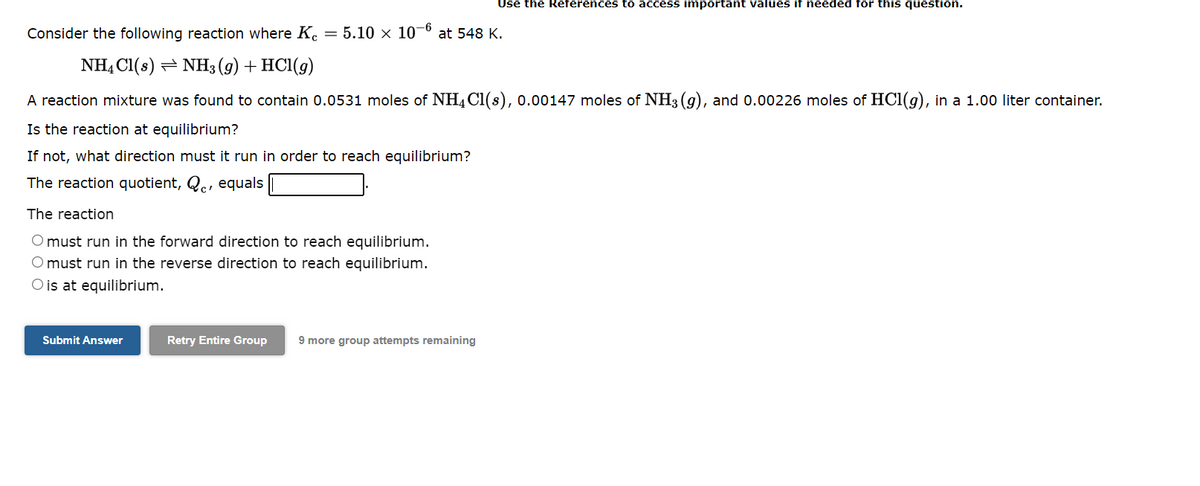Consider the following reaction where Ke = 5.10 x 10-6 at 548 K. NH4Cl(s) NH3(g) + HCl(g) A reaction mixture was found to contain 0.0531 moles of NH4Cl(s), 0.00147 moles of NH3(g), and 0.00226 moles of HCl(g), in a 1.00 liter container. Is the reaction at equilibrium? If not, what direction must it run in order to reach equilibrium? The reaction quotient, Q, equals The reaction O must run in the forward direction to reach equilibrium. O must run in the reverse direction to reach equilibrium. O is at equilibrium. Submit Answer Use the References to access important values if needed for this question. Retry Entire Group 9 more group attempts remaining
Consider the following reaction where Ke = 5.10 x 10-6 at 548 K. NH4Cl(s) NH3(g) + HCl(g) A reaction mixture was found to contain 0.0531 moles of NH4Cl(s), 0.00147 moles of NH3(g), and 0.00226 moles of HCl(g), in a 1.00 liter container. Is the reaction at equilibrium? If not, what direction must it run in order to reach equilibrium? The reaction quotient, Q, equals The reaction O must run in the forward direction to reach equilibrium. O must run in the reverse direction to reach equilibrium. O is at equilibrium. Submit Answer Use the References to access important values if needed for this question. Retry Entire Group 9 more group attempts remaining
Chemistry for Engineering Students
4th Edition
ISBN:9781337398909
Author:Lawrence S. Brown, Tom Holme
Publisher:Lawrence S. Brown, Tom Holme
Chapter12: Chemical Equilibrium
Section: Chapter Questions
Problem 12.22PAE
Related questions
Question

Transcribed Image Text:Consider the following reaction where Kc
NH4Cl(s) ⇒ NH3(g) + HCl(g)
A reaction mixture was found to contain 0.0531 moles of NH4Cl(s), 0.00147 moles of NH3(g), and 0.00226 moles of HC1(g), in a 1.00 liter container.
Is the reaction at equilibrium?
If not, what direction must it run in order to reach equilibrium?
The reaction quotient, Q, equals
=
Submit Answer
-6
5.10 x 107 at 548 K.
The reaction
O must run in the forward direction to reach equilibrium.
O must run in the reverse direction to reach equilibrium.
O is at equilibrium.
Use the References to access important values it needed for this question.
Retry Entire Group 9 more group attempts remaining
Expert Solution
This question has been solved!
Explore an expertly crafted, step-by-step solution for a thorough understanding of key concepts.
Step by step
Solved in 4 steps with 4 images

Knowledge Booster
Learn more about
Need a deep-dive on the concept behind this application? Look no further. Learn more about this topic, chemistry and related others by exploring similar questions and additional content below.Recommended textbooks for you

Chemistry for Engineering Students
Chemistry
ISBN:
9781337398909
Author:
Lawrence S. Brown, Tom Holme
Publisher:
Cengage Learning

Chemistry & Chemical Reactivity
Chemistry
ISBN:
9781337399074
Author:
John C. Kotz, Paul M. Treichel, John Townsend, David Treichel
Publisher:
Cengage Learning

Chemistry & Chemical Reactivity
Chemistry
ISBN:
9781133949640
Author:
John C. Kotz, Paul M. Treichel, John Townsend, David Treichel
Publisher:
Cengage Learning

Chemistry for Engineering Students
Chemistry
ISBN:
9781337398909
Author:
Lawrence S. Brown, Tom Holme
Publisher:
Cengage Learning

Chemistry & Chemical Reactivity
Chemistry
ISBN:
9781337399074
Author:
John C. Kotz, Paul M. Treichel, John Townsend, David Treichel
Publisher:
Cengage Learning

Chemistry & Chemical Reactivity
Chemistry
ISBN:
9781133949640
Author:
John C. Kotz, Paul M. Treichel, John Townsend, David Treichel
Publisher:
Cengage Learning

Chemistry: The Molecular Science
Chemistry
ISBN:
9781285199047
Author:
John W. Moore, Conrad L. Stanitski
Publisher:
Cengage Learning

General Chemistry - Standalone book (MindTap Cour…
Chemistry
ISBN:
9781305580343
Author:
Steven D. Gammon, Ebbing, Darrell Ebbing, Steven D., Darrell; Gammon, Darrell Ebbing; Steven D. Gammon, Darrell D.; Gammon, Ebbing; Steven D. Gammon; Darrell
Publisher:
Cengage Learning

Chemistry: Principles and Reactions
Chemistry
ISBN:
9781305079373
Author:
William L. Masterton, Cecile N. Hurley
Publisher:
Cengage Learning